
Publisher:
Bonnie King
CONTACT:
Newsroom@Salem-news.com
Advertising:
Adsales@Salem-news.com

~Truth~
~Justice~
~Peace~
TJP
Aug-11-2011 13:00

 TweetFollow @OregonNews
TweetFollow @OregonNews
Death of the Bees. Genetically Modified Crops and the Decline of Bee Colonies in North America
Brit Amos Special to Salem-News.comThis article was originally published by Global Research in March 2008.
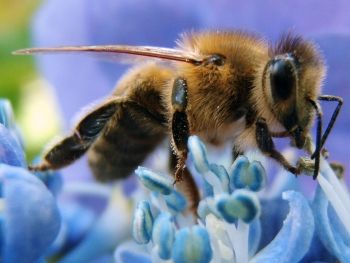 Courtesy: townipproject09.wikispaces.com |
(LONDON) - Commercial beehives pollinate over a third of [North}America’s crops and that web of nourishment encompasses everything from fruits like peaches, apples, cherries, strawberries and more, to nuts like California almonds, 90 percent of which are helped along by the honeybees. Without this pollination, you could kiss those crops goodbye, to say nothing of the honey bees produce or the flowers they also fertilize’..1
This essay will discuss the arguments and seriousness pertaining to the massive deaths and the decline of Bee colonies in North America. As well, it will shed light on a worldwide hunger issue that will have an economical and ecological impact in the very near future.
There are many reasons given to the decline in Bees, but one argument that matters most is the use of Genetically Modified Organisms (GMO) and "Terminator Seeds" that are presently being endorsed by governments and forcefully utilized as our primary agricultural needs of survival. I will argue what is publicized and covered by the media is in actuality masking the real forces at work, namely the impact of genetically modified seeds on the reproduction of bee colonies across North America.
Genetically modified seeds are produced and distributed by powerful biotech conglomerates. The latter manipulate government agricultural policy with a view to supporting their agenda of dominance in the agricultural industry. American conglomerates such as Monsanto, Pioneer Hybrid and others, have created seeds that reproduce only under certain conditions, often linked to the use of their own brands of fertilizer and/or insecticide.
The genetic modification of the plant leads to the concurrent genetic modification of the flower pollen. When the flower pollen becomes genetically modified or sterile, the bees will potentially go malnourished and die of illness due to the lack of nutrients and the interruption of the digestive capacity of what they feed on through the summer and over the winter hibernation process.
I will argue that the media reports tend to distract public opinion from the true cause which underlies the destruction of bee colonies. As such, outlined are four major arguments which the biotech conglomerates (which produce and market GMO seeds) have used to mislead the public regarding the demise of the bees. These arguments include Varroa mites, parasites, cell phones, and terminator seeds.
Argument 1: Varroa mites2
Firstly, “while there are some [people who] want to pin the blame on these mites”3, such views are unconvincing in that the argument does not make any sense because the main source of disease for these bees is intestinal disease. In fact, “many bee experts assumed Varroa mites were a major cause of the severe die-off in the winter of 2005. Yet when researchers from the U.S. Department of Agriculture (USDA) Bee Research Laboratory in Beltsville, Maryland, traveled to Oakdale, California, where Anderson and a number of his fellow beekeepers spend winter and spring, they could find no correlation between the level of Varroa mite infestation and the health of bee colonies. ‘We couldn’t pin the blame for the die-off on any single cause,’ says Jeff Pettis, a research entomologist from the U.S. Department of Agriculture (USDA) Bee Research Laboratory in Beltsville, Maryland,4 However, treatments against mites may be leaving hives open to the onslaught of powerful pathogens, much in the same way the overuse of antibiotics lead to super bugs”5 in society today. What does that say about our future? We have learned that in the 1960’s and 1970’s, among other human ailments, DDT was a major cause of cancer in humans and animals; however, the substitution of such pesticides was a closely guarded secret. Unfortunately, the long term effects on the human population has yet to be understood as the compromise of the immune system may be happening quicker than we are ready to accept, even regarding the advent of super bugs. One can see that even this medical implication has severe economical implications.
Argument 2: Parasites
Secondly; “Crops and even hedges, verges, and woodlands, and even where bees remain are sprayed with pesticides or herbicides. These chemicals are the practical extension of an exasperating belief that nature is our enemy. Pouring poison on our food is a very simplistic way of dealing with our problems however it ignores the root causes. New genetically modified crops, designed to be immune to certain pesticides and herbicides, have resulted in the increased usage of these chemicals. Pesticides, particularly Bayer’s imidacloprid, a nicotine-based product marketed under the names Admire, Provado, Merit, Marathon, and Gaucho have been concretely implicated6 in the destruction of bee populations before. (See also)7. The fact that other bees and insects are not raiding deserted hives to feed on the honey as they normally would lends some credence to the theory of a toxic overload”8. The toxic overload is certainly a concern, but wouldn’t it also need to be considered that this is systematic in the degeneration of the digestive process, such as in humans’ inability to digest preservatives and not absorb the enzymes to break down the foods eaten for survival?
Argument 3: cell phones
Thirdly, “there was also a misconstrued study on cell phone radiation 9 and its effects on the bee’s ability to navigate which turned out to be an over-zealous unthinking reaction by an article in the Independent [news]. Some have also mentioned other navigational hindrances such as UV radiation, shifting magnetic fields and even quantum physics10 as a reason to the destruction of the bees”11.
There is certain implications to this theory, and it has been proven that electromagnetic radio wave lengths to affect the navigation of the bees. However the sun emits radiation spurts all the time, yet this has not offered a hindrance to the bees.
Argument 4: Terminator Seeds
Lastly, “leaked documents seen by the Guardian show that Canada wants all governments to accept the testing and commercialization of “Terminator” crop arieties. These seeds are genetically engineered to produce only infertile seeds, which farmers cannot replant, also to mention that the bees that are trying to collect pollen, found to have their digestive tract diseases, such as amoeba and nosema disease”12. These diseases are mainly located in the digestive tract system. After studies of the autopsy, the most alarming trait is that the lower intestine and stinger have discolored to black vs. the normal opaque color, Synominus with colon cancer in humans.
Figure 1: Extreme discoloration of intestinal tracts of bees.
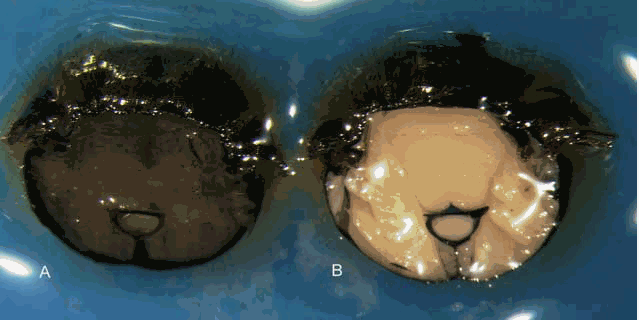
‘When thoracic discs were cut from sample Georgia A-2 the musculature of bees was notably soft and discolored (A) when compared to healthy thoracic cuts (B).
This discoloration suggests that the bees were dead upon collection. When questioned the beekeeper confirmed that the bees were alive at the time of collection. Further, the tracheal system of these bees did not show signs of desiccation usually associated with the collection of dead bees. Thoracic discs from this sample, after being placed in KOH for 24 hours, revealed peculiar white nodules”13
As seen above, it is certain that the digestive shutdown is due to hard material in the digestive tract that compromises the immune system. Circulatory problems would without doubt. Could it be that humans are going through the same process with the rise of Colon Cancer? As seen below in the comparison of the healthy Bee and the unhealthy bee, it is obvious that the bees that are ingesting GMO pollen are having severe digestive problems, so severe that the disease is terminal.
Figure 2: Digestive shutdown of the Honey Bee
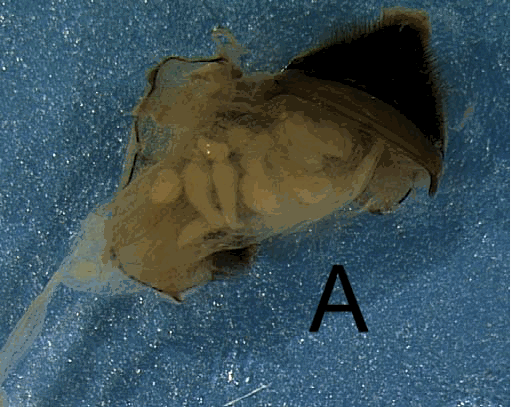
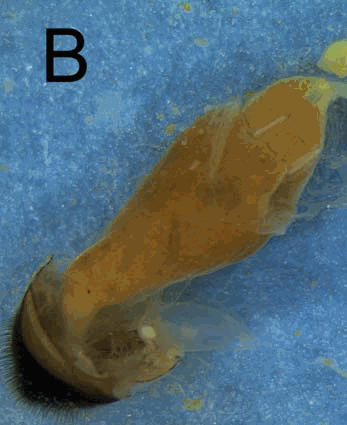
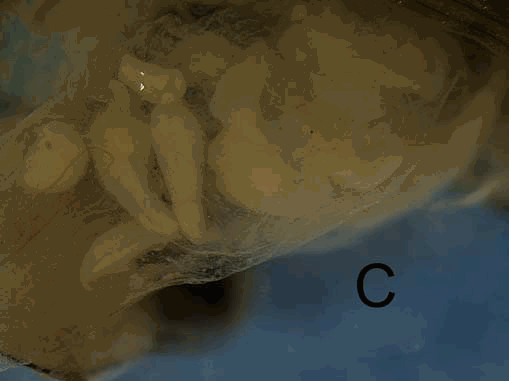
The rectal contents of Georgia bees (A) were distinctly different then the contents of Pasadena bees (B). The rectal walls of GA bees were notably transparent revealing contents that looked like small stone packets (C). While Fyg (1964) describes similar stone like contents in poorly laying queens, the stones observed in the GA bees were not attached to the epithelium layer as Fyg (1964) describes. When these packets were ground and mounted, some unidentified floating objects (UFO’s) were observed. A cubic particle that resembles the cubic bodies of polyhedrios viruses (this viruses attacks wax moths) excepting that the cube observed was ~10x too big for a virus particle. There were fragments of pollen grains husks in all samples examined. All PA samples were found to have nosema spores in their rectal contents while none of the GA samples did. In two samples, epithelial cells were packed with spores.14
The North American reliance on bees for pollination is at minimum from 30 to 40%. Does it not seem obvious that the digestion of genetic material directly affects the digestive process of the bees? Could it also be that there are similarities in the human population's digestive process? It must also be noted that this increased epidemic of the bee colony collapse has risen significantly since the use of GMO in our foods. It is also suspect in the rise of new cases of medical ailments in humans such as colon cancer, obesity, heart disease, etc... In the writers’ opinion, the inability of the bees to pass matter digestively is quite similar to the present-day problems in the human digestive system
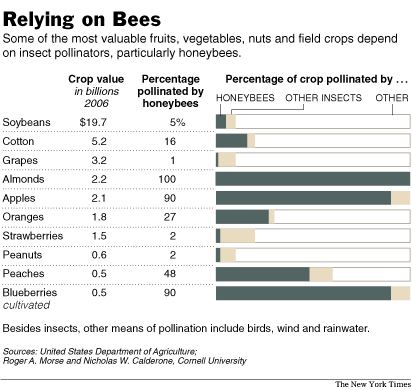
Conclusion:
The proof is obvious that one of the major reasons of the bees’ decline is by the ingestion of GMO proteins. This is problematic, as there is such an increase of indigestible foods in humans and bees. The situation of colon cancer in humans is somewhat similar in occurrence. This is only a theory but leaves one to wonder what are we eating en mass. The external or complementary good of the bee is obviously a rise for a global concern. The long-term economical and environmental impact has yet to be completely understood.
The Ecological Impact of horizontal gene transfer and increase of rampant disease is not fully examined and if so, is kept silent by these Conglomerates. The Economic impact of the bee colony collapse would mean inflation, scarcity of agricultural commodities, and ultimately the collapse of North American agriculture.
The Environmental Impact of scarcity and increased demand for resources, will beyond doubt have severe repercussions for our long-term food security. The bio-diversity of the bees causes positive economic and ecological externalities. The negative externalities have yet to be fully grasped or understood.
Organic crops: still relatively untouched
The truth is that organic farming is relatively untouched as the bee crisis is concerned. Organic farming maintains the diversity of the eco-system and preserves the quality of the foods produced. The economic impact that the scarcity of bees will potentially have on our society as a whole is very worrisome. In the end, only our children will fully realize; that it was greed that destroyed our beautiful blue planet.
References:
Thill, John. Colony Collapse: Do Massive Bee Die-Off Mean an End to Our Food System as We Know it? AlterNet
http://www.alternet.org/module (Accessed 7/9/2007 10:06 PM)
Colony Collapse Disorder: Wikkapedia Encyclopedia Online
http://en.wikipedia.org/wiki/’Colony Collapse Disorder’
(Accessed July 12, 2007)
Colony Collapse Disorder (CCD)
www.ento.psu.edu/MAAREC/pressReleases/FallDwindleUpdate0107.pdf <
(Accessed June 30, 2007)
CROP PROTECTION. Monthly 28 February 2001 – Issue No 135
Market Scope Europe Ltd.
http://www.crop-protection-monthly.co.uk (Accessed July 10, 2007)
HONEY BEE Research Program. RIRDIC Honeybee Research Program Home Page. http://rirdic. gov.au/program/hb.html#top, (Accessed July 7, 2007)
Ho, Dr. Mae-Wan. ‘Recent Evidence Confirms Risks of Horizontal Gene Transfer’. ISIS Contribution to ACNFP/Food Standards Agency Open Meeting 13 November 2002, Institute of Science in Society, PO Box 32097, London NW1 0XR (Accessed July 16, 2007)
ISIS Contribution. ‘Recent Evidence Confirms Risks of Horizontal Gene Transfer”. ISIS Contribution to ACNFP/Food Standards Agency Open Meeting 13 November 2002 (Accessed July 17, 2007)
Mackintosh, Craig. (April 13, 2007): ‘Colony Collapse Disorder– a moment of reflection’;
http://www.celsias.com/2007/04/13/colony-collapse-disorder-a-moment-for-reflection/ (Accessed July, 2007)
Vidal, John. ‘Canada backs terminator seeds’, The Guardian. Wednesday, February 9, 2005.
http://www.guardian.co.uk/gmdebate/Story/ (Accessed July 17, 2007)
Wilson, Dan. Lost colonies: ‘Where have the bees gone’? Appelton Post-Crescent, 5/18/2007 (Accessed July 19, 2007)
What’s Causing the Mass Disappearance of Honeybees? ‘What is causing the Dramatic decline in Honeybee Populations in the U.S and Elsewhere in Recent years’? HealthNewsDigest.com – New York, NY, June 2, 2007
www.emagazine.com/earthtalk/archives.php (Accessed July 10, 2007)
Notes
1 Hill, Scott. AlterNet, Posted on June 11, 2007, Printed on July 9, 2007
http://www.alternet.org/story/53491/
2 http://www.nrdc.org/onearth/06sum/bees2.asp
3 Mackintosh, Craig. (April 13, 2007): ‘Colony Collapse Disorder– a moment of reflection’; Celsias;
http://www.celsias.com/2007/04/13/colony-collapse-disorder-a-moment-for-reflection/ ‘
4 ‘The Vanishing’
http://www.nrdc.org/OnEarth/06sum/bees1.asp
5 Mackintosh, Craig. (April 13, 2007): ‘Colony Collapse Disorder– a moment of reflection’; Celsias;
http://www.celsias.com/2007/04/13/colony-collapse-disorder-a-moment-for-reflection/ ‘
6 http://www.valleyvoicenewspaper.com/vv/stories/beedeaths.htm
7 http://independent.co.uk/environment/news/article2449968
8 Mackintosh, Craig. (April 13, 2007): ‘Colony Collapse Disorder– a moment of reflection’; Celsias;
http://www.celsias.com/2007/04/13/colony-collapse-disorder-a-moment-for-reflection/
9 http://www.newmediaexplorer.org/sepp/2003/11/26/millions_of_bees_dead_bayers_gaucho_blamed.htm
10 http://www.synchronizm.com/blog/index.php/2007/03/29/the-bees-who-flew-too-high/
11 Mackintosh, Craig. (April 13, 2007): ‘Colony Collapse Disorder– a moment of reflection’; Celsias;
http://www.celsias.com/2007/04/13/colony-collapse-disorder-a-moment-for-reflection/
12 Vidal, John. ‘Canada backs terminator seeds’ Wednesday February 9, 2005. The Guardian
http://www.guardian.co.uk/gmdebate/Story/
13 Fall Dwindle Disease: A preliminary report
http://www.ento.psu.edu/MAAREC/pressReleases/FallDwindleUpdate0107.pdf
December 15, 200614 Fall Dwindle Disease: A preliminary report
http://www.ento.psu.edu/MAAREC/pressReleases/FallDwindleUpdate0107.pdf
December 15, 2006
Articles for August 10, 2011 | Articles for August 11, 2011 | Articles for August 12, 2011
Quick Links
DINING
Willamette UniversityGoudy Commons Cafe
Dine on the Queen
Willamette Queen Sternwheeler
MUST SEE SALEM
Oregon Capitol ToursCapitol History Gateway
Willamette River Ride
Willamette Queen Sternwheeler
Historic Home Tours:
Deepwood Museum
The Bush House
Gaiety Hollow Garden
AUCTIONS - APPRAISALS
Auction Masters & AppraisalsCONSTRUCTION SERVICES
Roofing and ContractingSheridan, Ore.
ONLINE SHOPPING
Special Occasion DressesAdvertise with Salem-News
Contact:AdSales@Salem-News.com
Salem-News.com:

googlec507860f6901db00.html


Terms of Service | Privacy Policy
All comments and messages are approved by people and self promotional links or unacceptable comments are denied.
Elizabeth Wolff March 1, 2013 8:04 am (Pacific time)
How can I e-mail this article? How can we get the U.S. to stop Monsanto before we lose all our bees? GM foods must be prohibited! How can we stop Monsanto!
[Return to Top]Hit the print button and copy the entire article and drop it right onto the face of an email, or you can copy it artwork and all and that will email too. Thanks!
©2025 Salem-News.com. All opinions expressed in this article are those of the author and do not necessarily reflect those of Salem-News.com.